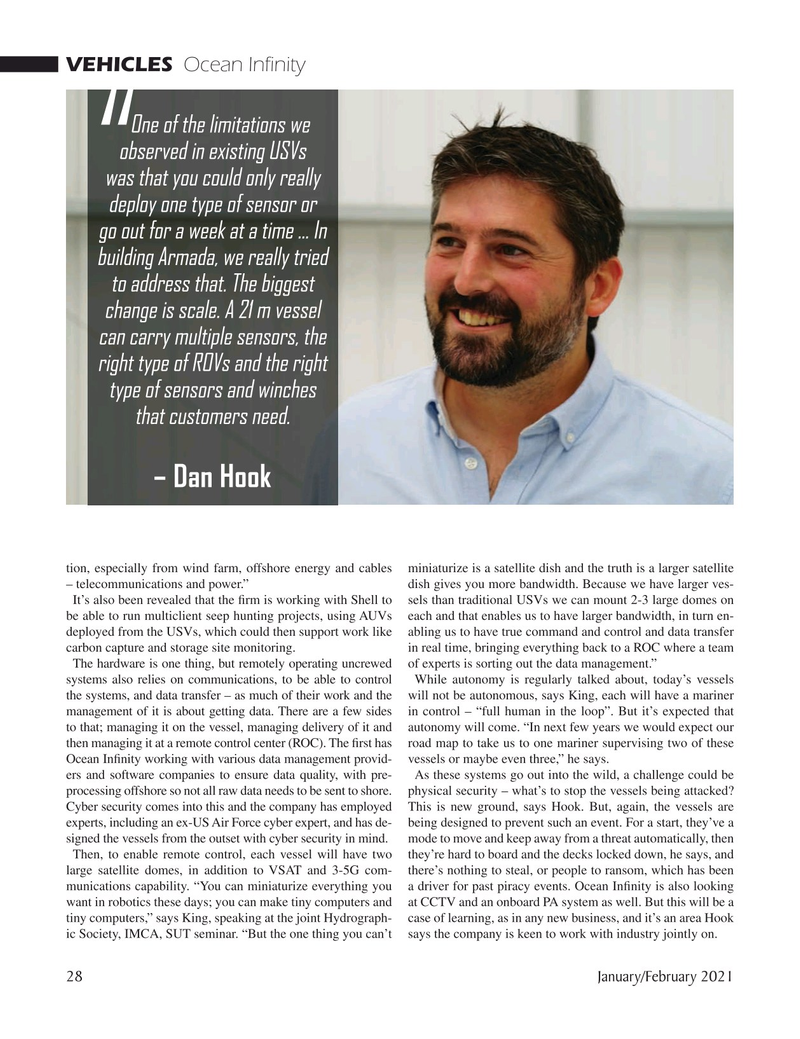
Page 28: of Marine Technology Magazine (January 2021)
Underwater Vehicle Annual
Read this page in Pdf, Flash or Html5 edition of January 2021 Marine Technology Magazine
VEHICLES Ocean Infinity
One of the limitations we observed in existing USVs was that you could only really deploy one type of sensor or go out for a week at a time ... In building Armada, we really tried to address that. The biggest change is scale. A 21 m vessel can carry multiple sensors, the right type of ROVs and the right type of sensors and winches that customers need. – Dan Hook tion, especially from wind farm, offshore energy and cables miniaturize is a satellite dish and the truth is a larger satellite – telecommunications and power.” dish gives you more bandwidth. Because we have larger ves-
It’s also been revealed that the ? rm is working with Shell to sels than traditional USVs we can mount 2-3 large domes on be able to run multiclient seep hunting projects, using AUVs each and that enables us to have larger bandwidth, in turn en- deployed from the USVs, which could then support work like abling us to have true command and control and data transfer carbon capture and storage site monitoring. in real time, bringing everything back to a ROC where a team
The hardware is one thing, but remotely operating uncrewed of experts is sorting out the data management.” systems also relies on communications, to be able to control While autonomy is regularly talked about, today’s vessels the systems, and data transfer – as much of their work and the will not be autonomous, says King, each will have a mariner management of it is about getting data. There are a few sides in control – “full human in the loop”. But it’s expected that to that; managing it on the vessel, managing delivery of it and autonomy will come. “In next few years we would expect our then managing it at a remote control center (ROC). The ? rst has road map to take us to one mariner supervising two of these
Ocean In? nity working with various data management provid- vessels or maybe even three,” he says. ers and software companies to ensure data quality, with pre- As these systems go out into the wild, a challenge could be processing offshore so not all raw data needs to be sent to shore. physical security – what’s to stop the vessels being attacked?
Cyber security comes into this and the company has employed This is new ground, says Hook. But, again, the vessels are experts, including an ex-US Air Force cyber expert, and has de- being designed to prevent such an event. For a start, they’ve a signed the vessels from the outset with cyber security in mind. mode to move and keep away from a threat automatically, then
Then, to enable remote control, each vessel will have two they’re hard to board and the decks locked down, he says, and large satellite domes, in addition to VSAT and 3-5G com- there’s nothing to steal, or people to ransom, which has been munications capability. “You can miniaturize everything you a driver for past piracy events. Ocean In? nity is also looking want in robotics these days; you can make tiny computers and at CCTV and an onboard PA system as well. But this will be a tiny computers,” says King, speaking at the joint Hydrograph- case of learning, as in any new business, and it’s an area Hook ic Society, IMCA, SUT seminar. “But the one thing you can’t says the company is keen to work with industry jointly on. 28 January/February 2021
MTR #1 (18-33).indd 28 1/25/2021 9:09:03 AM

 27
27

 29
29
